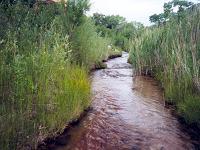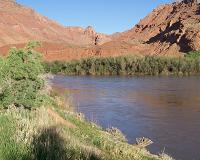
A lower riparian zone
Courtesy and
Copyright © Charles Hawkins
Hi, I’m Holly Strand from Stokes Nature Center in beautiful Logan Canyon.
When you think of Utah, a number of iconic landscapes come to mind. The arches, buttes and mesas in southeastern Utah’s red rock country; the snow-capped mountains of the majestic Wasatch Range, the endless horizon of the Bonneville Salt Flats and the immense expanse of the Great Salt Lake. But the most critical ecosystem in terms of life support for Utah’s plants and animals is not always recognized. I’m referring to riparian zones. These are the ecosystems that occur along the banks of streams and rivers. They are most recognizable in the desert where they occur as distinctive green strips of vegetation along waterways. But they also occur in grasslands, shrublands and forests albeit with different compositions of plants and animals.
Riparian areas provide all the basic needs of life – food, water and shelter from predators – in a surprisingly compact space. Intact riparian zones are physically complex, with a layer of grass, then shrubs, then upper canopy trees. This structural complexity creates a number of biological niches. That’s why the highest levels of biodiversity are consistently found there. Average bird densities are approximately twice as high in riparian areas as in adjacent upland areas. And more wildlife species use riparian areas than all other habitats in Utah combined. Even fish populations are higher in streams adjacent to riparian areas. Fish use woody debris as shelter, and the vegetation stabilizes stream channels and reduces temperature fluctuations in the water.
Riparian areas only cover about one half of one percent of Utah’s total land area. Above 5500 feet the dominant woody plants are willow, cottonwood, water birch, black hawthorn and wild rose. Common animals include the northern river otter, the beaver, American dipper, smooth greensnake and the rubber boa.

populates a lower riparian
zone in Professor Valley along
the Colorado River
Courtesy and
Copyright © 2009 Holly Strand
Lowland riparian areas represent one of the rarest habitats in the state-covering only 0.2 percent of Utah’s total land area. Fremont cottonwood, netleaf hackberry, velvet ash, desert willow and squaw-bush are the most visible plants here. The exotic tamarisk and Russian olive are now frequently part of the lowland mix. Mollusks, broad-tailed hummingbirds, canyon treefrogs, Allen’s big-eared bats, yellow-billed cuckoos, and many other animals depend on lowland riparian habitats. My personal riparian favorite is the belted kingfisher that patrols the green-lined waterways in search of tasty fish.
Humans were originally riparian creatures. But once we learned to pipe and move water at will, we were free to settle elsewhere. Nevertheless, we are still attracted to aquatic landscapes. So Utah’s riparian areas have taken on a recreational function for many of us. They offer great fishing, they cool us off as we paddle or float, and they provide a quiet sanctuary to enjoy the sight and sound of water. Best of all, riparian areas offer an excellent opportunity to catch a glimpse of Utah’s amazing wildlife.
Thanks to the USU College of Natural Resources for supporting research and development of this Wild About Utah topic. And thanks to Frank Howe of the Utah Division of Wildlife Resources and. Charles Hawkins of USU’s Watershed Science Department for their help with the scientific content of this piece.
For Wild About Utah and Stokes Nature Center, I’m Holly Strand.
Credits:
Text: Stokes Nature Center: Mary-Ann Muffoletto, Frank Howe & Holly Strand
Additional Reading:
“Commonly Asked Questions About Riparian Management Systems,” Agroecology Issue Team, Leopold Center for Sustainable Agriculture, Iowa State University.
https://www.buffer.forestry.iastate.edu/Assets/FAQ.pdf
Hawkins, Charles P. “What are Riparian Ecosystems and Why are We Worried About Them?” Riparian Resources: A Symposium on the Disturbances, Management, Economics and Conflicts Associated with Riparian Ecosystems, Natural Resources and Environmental Issues, Volume I, 1994, College of Natural Resources, Utah State University.
https://www.cnr.usu.edu/quinney/files/uploads/NREI1.pdf
State of Utah, Division of Wildlife Resources. Lowland Riparian Habitat. https://wildlife.utah.gov/cwcs/01.pdf [ accessed May 11, 2009 ]
State of Utah, Division of Wildlife Resources. Mountain Riparian Habitat. https://wildlife.utah.gov/cwcs/03.pdf [ accessed May 11, 2009 ]
